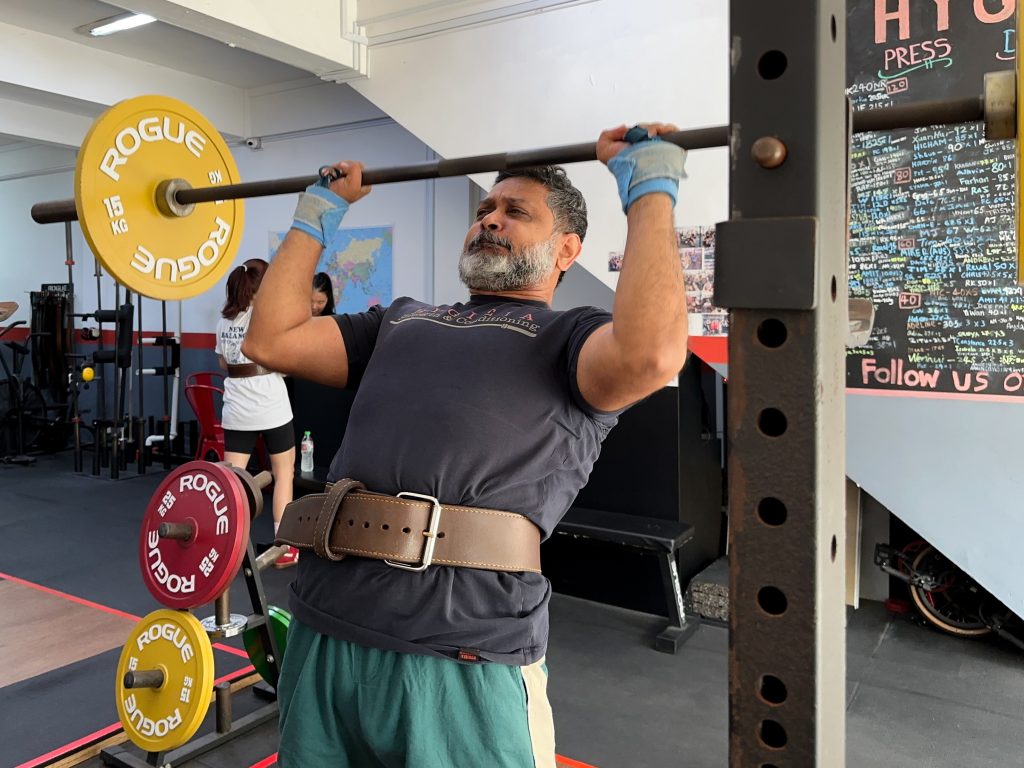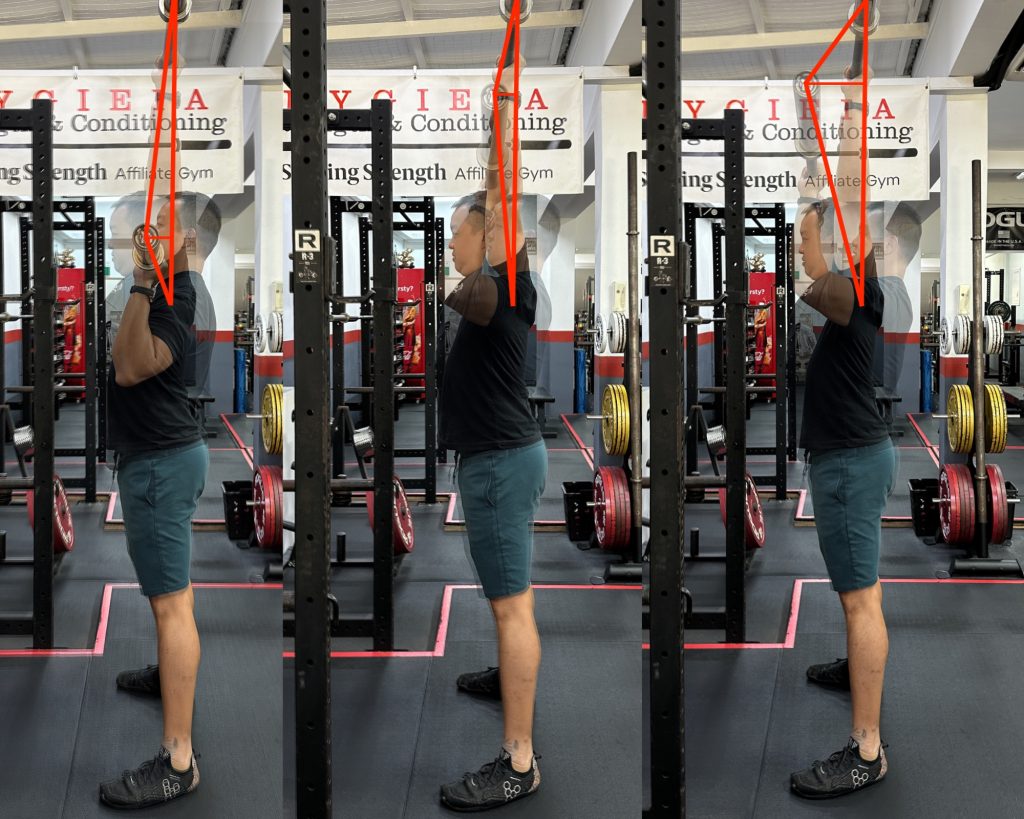
All it takes is the tiniest bar path misgroove to deny you of a successful press PR attempt. Read on to discover how to manage moment forces and improve your pressing technique.
The problem: why lifters miss heavy presses
Train long enough and you’ll experience this: you’re pressing or benching a heavy set of five and the first two reps move smoothly. No problem, you got this. Then suddenly, on the third rep, when the bar is about halfway on the way up, no matter how hard you push, it feels impossibly heavy and refuses to budge. The bar then goes back down, and you miss the rep. What happened?
What’s almost certainly the cause: on both the press and bench press, you unconsciously press the bar “away” from your shoulder joint. On the press, this means the bar drifts forward (anteriorly). On the bench, it travels toward your feet (inferiorly). Same problem, different direction – and both will cause you to miss reps.
Why does this matter? Because every millimetre the bar deviates from its optimal path increases the amount of force needed to get the bar to the lock out position. When that happens, you’re not lifting against gravity alone – you’re battling additional moment forces that make the weight feel heavier than it actually is. So you either have to produce enough force to overcome the extra forces, or you miss the rep.
The physics: understanding moment forces
Let’s talk about some physics
For efficiency when performing the basic barbell lifts, we want a perfectly vertical bar path. (The only exception is the bench press, which uses a diagonal path to avoid shoulder impingement.) But here’s the frustrating part: even when actively coached, and the lifter knows this, pressing the bar “away” remains incredibly common.
The reason is moment forces. If they are not actively counteracted, they cause rotational instability.

Comparison of moment arms between the shoulder joint (point of rotation) and the barbell (load)
The heavier the weight on the bar, the more pronounced the effect of a tiny bar path deviation, which increases the likelihood that you’ll miss the rep. When you start pressing the bar away from the ideal bar path, you create a longer moment arm between your shoulder (the point of rotation) and the barbell (the load). This increases moment force, creating rotational instability, which causes it to drift even further away.
The further the load strays from the point of rotation, the more moment force it generates. With light weights, you might overcome the inefficiency with brute force. Heavy weights? You’ll miss the rep.
Mechanics for overhead press vs bench press
While the principles remain consistent, the moment forces are presented differently for each lift.
The press
The press starts you at an immediate disadvantage. Unlike the bench press, where you start with the bar directly over your shoulder joint, your head forces the barbell to sit slightly forward of your shoulder. This unavoidable situation creates an initial moment arm that you have to manage.
This might explain why forward drift plagues the press more than the bench press. One of the reasons why we utilise the press 2.0 technique is to minimise this disadvantage by shortening the distance between the barbell and shoulder.
Here’s what most lifters don’t realise: pressing the barbell in a truly vertical line feels like you’re pressing back and up simultaneously, even though you’re actually pressing straight up.
Tell untrained lifters to “press straight up,” and they’ll press forward and lock out with the bar positioned in front of their head every single time. Why? Because that’s what “straight up” feels like to their biological programming. My hypothesis of why this happens is that humans are anterior-oriented creatures – we’re naturally wired for forward movement patterns. That, and they don’t want to hit their face with the bar.
The bench press
The bench press operates differently. Its bar path is intentionally non-vertical to prevent shoulder impingement.
But here’s where it gets tricky: as you lower the barbell to your chest, the horizontal distance between the bar and your shoulder joint lengthens, increasing the moment arm. To press the bar back up to over the shoulder joint, you now have to do work against both gravity and moment.
Many lifters fixate on only one goal: press the bar up. You need to produce force to overcome both gravity and moment force simultaneously, or the bar will continue rotating away from your shoulder joint. Instead of driving up and back toward the shoulders, you end up pressing inferiorly, which only further increases the moment arm and makes everything even more difficult.
I see this from time to time in the gym. When the bar gets stuck halfway because it’s hovering forward in either press, I cue the lifter to “press back (toward your shoulders)”. The moment the distance between the bar and the shoulder joint starts to shorten, the bar continues its upward trajectory. Managing moment forces isn’t just theory – it can be the difference between making and missing your reps.
Solutions for fixing your bar path
Understand two fundamental principles for efficient pressing:
First, keep your elbow joints directly beneath the barbell throughout the entire range of motion. Then think about pushing up from your elbows. This sounds elementary, but maintaining this position under heavy load requires awareness and effort.
Second, the pressing direction differs between lifts. On the bench press, you want to press diagonally – up and back toward your shoulders simultaneously. On the overhead press, you’re actually pressing vertically, but it feels like you’re pressing up and back.
Press-specific fixes
The nose target method: Aim to “hit your nose” with the barbell. This cue keeps the bar staying close to your face throughout the movement, preventing forward drift.
Drive from your elbows: Instead of thinking about pushing with your hands, imagine the bar is sitting atop your elbows and focus on driving up and back with your elbows.
The rack proximity technique: Press from a position closer to the rack than you usually do. After unracking, take a small step back – just enough to clear the J-hooks. Having the rack in your peripheral vision creates a subconscious cue – your brain instinctively avoids hitting the rack by keeping the bar close to your face.
What if you can’t get into the ideal bar path and lockout position due to limited shoulder flexibility? With your limitations in mind, we will work to modify technique around your structural limitations, but still trying as much as possible to achieve the optimal bar path.
Bench press-specific fixes
After unracking and positioning the bar directly over your shoulder joint, identify a specific spot on the ceiling above you. Lock onto it and note exactly where the barbell is in relation to that reference point. For every rep, drive the bar back to that exact spot. This creates a consistent visual target that usually results in an optimal bar path.
Fix your bar path, improve your press
An efficient bar path is absolutely critical when lifting heavy weights – the heavier the weight on the bar and the closer you are to lifting to your maximum ability, the slimmer the allowable tolerance for deviations. The difference between successful PRs and leaving weight on the platform can come down to these seemingly small technical details.
Now you understand exactly why you tend to press the bar forward and, more importantly, how to prevent it from happening. Incorporate these cues the next time you press and bench and feel the difference.

